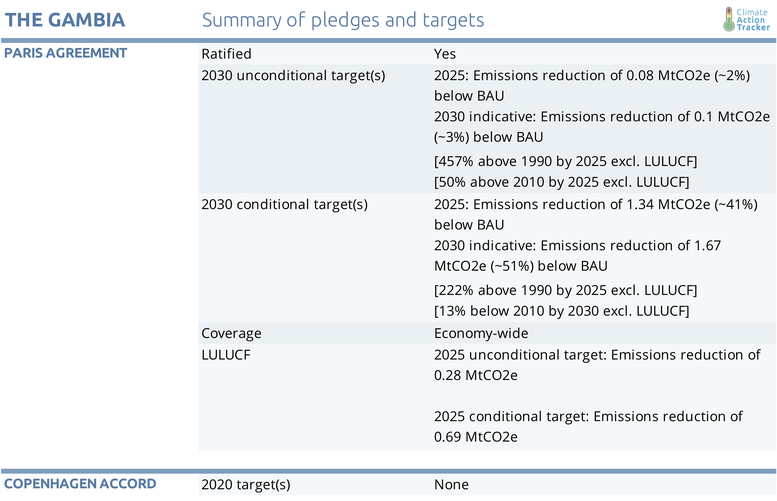Pledges And Targets
Summary table

Paris Agreement
On November 2016, The Gambia submitted its NDC, with the aim of unconditionally reducing GHG emissions excl. LULUCF using renewable energy sources by 0.079 MtCO2e below BAU in 2025 (Government of The Gambia 2016). The Gambia would increase its GHG reductions to 1.42 MtCO2e excl. LULUCF in 2025 if it receives financial and technical support. By 2030, implementation of the unconditional mitigation targets would result in emissions reductions of 0.10 MtCO2e excl. LULUCF, while the conditional actions would lead to a 1.77 MtCO2e abatement. While The Gambia presents emissions levels for both 2025 and 2030 in its NDC, the document does not recognise the years after 2025 as part of the commitment. So, we rate the NDC according to the 2025 target and interpret the 2030 values as indicative projections.
The Gambia provides a set of quantified sectoral measures to indicate how it is planning to reach its targets between 2021 and 2025: Its unconditional target will be met by deploying renewable energy, and this target is estimated to abate 0.079 MtCO2e. Its conditional target is estimated to abate an additional 1.34 MtCO2e, and will be reached through improving energy efficiency in the power system, and in the buildings, transport, agriculture and waste sectors, as well as expanding its renewable energy target. The total expected mitigation from all of these actions would result in an emission level of 1.77 MtCO2e excl. LULUCF in 2030, which is equivalent to 37% below the BAU scenario.
In addition, The Gambia plans to unilaterally abate 0.28 MtCO2e in the LULUCF sector through afforestation by 2025. By 2025, it intends to abate 0.69 MtCO2e by replacing flooded rice fields by dry upland ones and by using efficient cook stoves to reduce the overuse of forest resources, conditional on international support.
The NDC indicated that there are “low” and “medium” emissions BAU scenarios. The NDC is relative to the low emissions BAU scenario. According to its NDC, The Gambia’s emissions are projected to grow by 3% annually until 2030. It indicates there are other scenarios assuming higher economic growth, but those have not been made publicly available.
Further analysis
Latest publications
Stay informed
Subscribe to our newsletter




